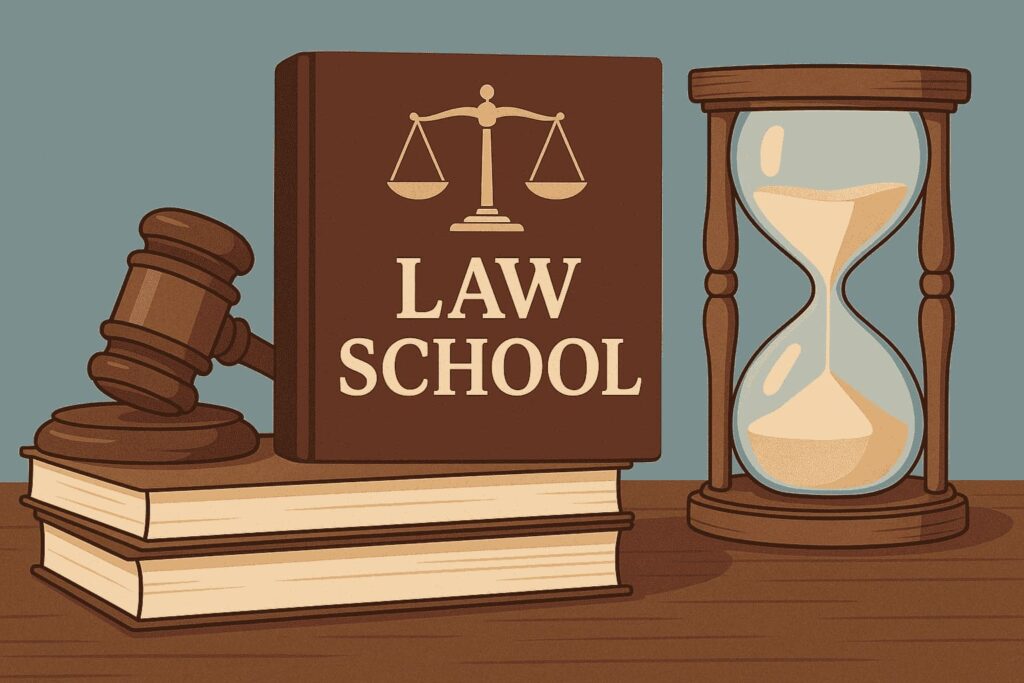Law school isn’t one-size-fits-all. The length ranges from two to seven years depending on where you study, whether you go full-time or part-time, and what kind of license you want at the end. Below is a clear, country-by-country map plus the extras that can stretch or shorten the journey.
The short answer
- United States: The JD is 3 years full-time (often 4–5 part-time), typically after a 4-year bachelor’s. Most graduates spend a summer studying for the bar exam and are admitted several months later. From first day of undergrad to law license, think 7–8 years on a conventional timeline.
- United Kingdom (Solicitor route): A law degree (LLB) is 3 years in England and Wales, followed by the SQE exams and 2 years of qualifying work experience (QWE) that can overlap with exam prep. Non-law grads can do a 1-year law conversion then SQE + QWE. Expect 4–6 years post-secondary, depending on your starting point and how you schedule QWE.
- Canada: The JD is 3 years after a prior degree, then a bar course/exam plus articling (usually 8–12 months). Plan for 7–8 years end-to-end.
- Australia: Either a 4-year LLB (direct from secondary school) or a 3-year JD after a prior degree, then Practical Legal Training (PLT) of about 6 months before admission. Total 3.5–4.5 years after finishing secondary school (LLB route) or about 3.5 years after your first degree (JD route).
- India: Two main options: a 5-year integrated BA LL.B. straight from secondary school, or a 3-year LL.B. after a bachelor’s. Graduates enroll with a State Bar Council and pass the All India Bar Examination. That’s 3 or 5 years for the degree, plus licensing steps.
- Civil-law examples (varies): In countries like Germany or France the path includes university study plus state or professional training phases. Expect 5–7+ years from start of university to full qualification, depending on exams and traineeships.
What’s counted as “law school” vs. licensing
“Law school” usually means the academic degree (JD, LLB, or equivalent). Becoming a practicing lawyer also requires licensing: bar exams, structured training (articling, traineeships, PLT, QWE), character and fitness checks, and formal admission. Those steps can add months to a year or more, even after you’ve finished classes.
United States in detail
Full-time JD programs run six semesters across three academic years. The first year is lockstep (contracts, torts, civil procedure, criminal law, property, legal writing). Years two and three are electives, clinics, journals, moot court, externships, and any concentrations.
After graduation in May, most students study 8–10 weeks for the July bar exam. Results arrive in late summer or fall; admission follows. Part-time and evening divisions spread coursework over four years or more. A handful of schools offer accelerated JDs (finishing in 2–2.5 years) by using summers intensively.
United Kingdom in detail (England & Wales, solicitor route)
A standard LLB is three years. Non-law graduates can take a one-year law conversion (often called PGDL), then sit SQE1 (legal knowledge) and SQE2 (practical skills). You also need two years of QWE, which you can collect before, during, or after the SQE across up to four organizations. That flexibility means motivated candidates can stack SQE prep with paid work, while others take a more sequential approach. Barrister training has its own pathway via the Bar Course and pupillage (typically one year).
Canada in detail
Canadian law schools award a three-year JD. After graduation, provinces require a licensing process: a bar exam or course plus articling (supervised legal work, usually 8–12 months). Some provinces offer a Law Practice Program in place of articling. Timing can be smooth—degree in spring, articling through the next year—or extended if placements take longer to secure.
Australia in detail
Choose a four-year LLB out of secondary school or a three-year JD after an initial degree. To be admitted, you complete PLT (often a Graduate Diploma in Legal Practice) that blends coursework and a short traineeship, commonly around six months. Many students start PLT soon after finishing their last law subjects, so the transition is relatively quick.
India in detail
The five-year integrated BA LL.B. combines general studies and law from the outset. The three-year LL.B. is a post-graduate degree taken after you complete a bachelor’s in another field. After the degree, you enroll with a State Bar Council; the AIBE confirms eligibility to practice. Timelines are straightforward, but regional administration can influence how fast you get your enrollment and certificate.
Accelerated, part-time, and dual-degree twists
Not everyone follows the default clock. A few examples:
- Accelerated programs: Select U.S. schools compress the JD to 2–2.5 years; the UK’s graduate-entry LLB can be 2 years for non-law grads; some Australian universities run trimester calendars to finish a JD faster.
- Part-time/evening: Common in the U.S.; finishing in 4–5 years is typical if you work while studying.
- Dual degrees: JD-MBA, JD-MPA, JD-MS or LLB-BCom can add 6–18 months, depending on credit-sharing rules and internship requirements.
The real-world calendar
From your first application to your first day in practice, there are quiet stretches and bottlenecks:
- Applications often start 9–12 months before classes begin.
- Internships and clinics fill summers and can shape job offers.
- Bar prep and training blocks are fixed points you can’t skip; stacking them tightly shortens the total path but increases workload.
What slows people down (and what speeds them up)
Life, work, and money are the usual variables. Part-time study trades calendar years for steady income. Changing jurisdictions may require extra exams or credential assessment. On the flip side, careful planning—front-loading prerequisites, using summer terms, securing training placements early—can cut idle time between degree and license.
Bottom line
“How long is law school?” ranges from 2 to 5 years for the degree itself, depending on country and format, and roughly 6 to 8+ years from the start of university to full licensure in systems that require a prior bachelor’s and post-degree training. The precise timeline is a policy choice by each jurisdiction. Your best move is to pick the destination first (where you want to practice) and then build the shortest, most direct path that jurisdiction offers.
sources
- American Bar Association — Law school basics and JD program structure
https://www.americanbar.org/groups/legal_education/resources/for_students/ - Solicitors Regulation Authority (England & Wales) — SQE route and qualifying work experience
https://www.sra.org.uk/students/sqe/ - Federation of Law Societies of Canada — National admission standards and licensing components
https://flsc.ca/national-initiatives/national-admission-standards/
Also read:


